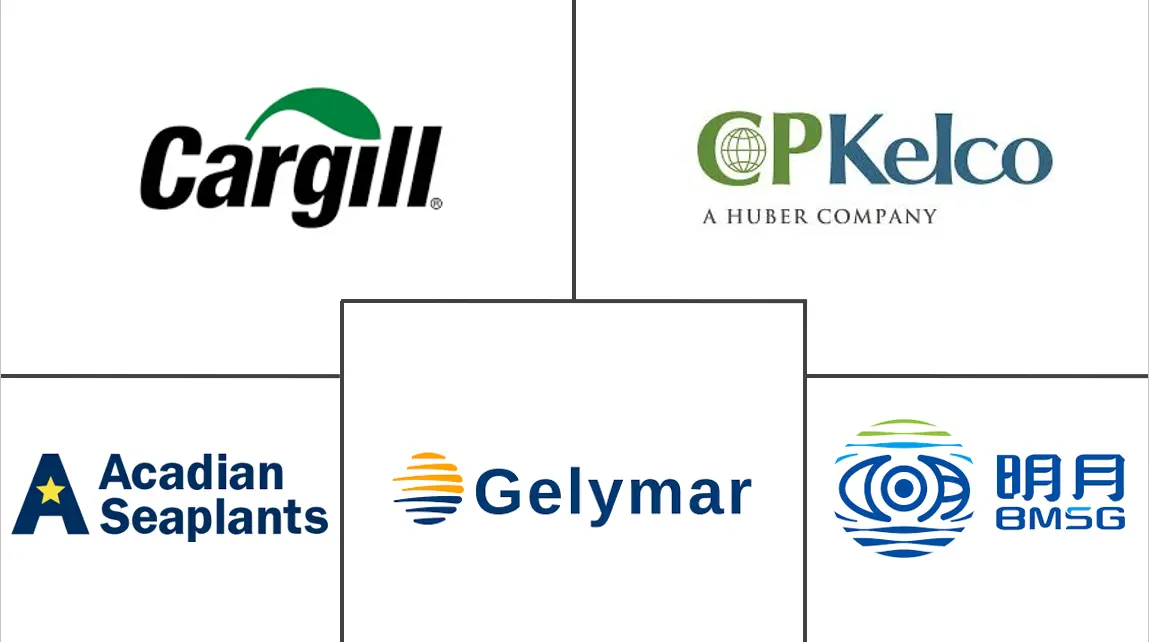Commercial Seaweed Market Size and Share
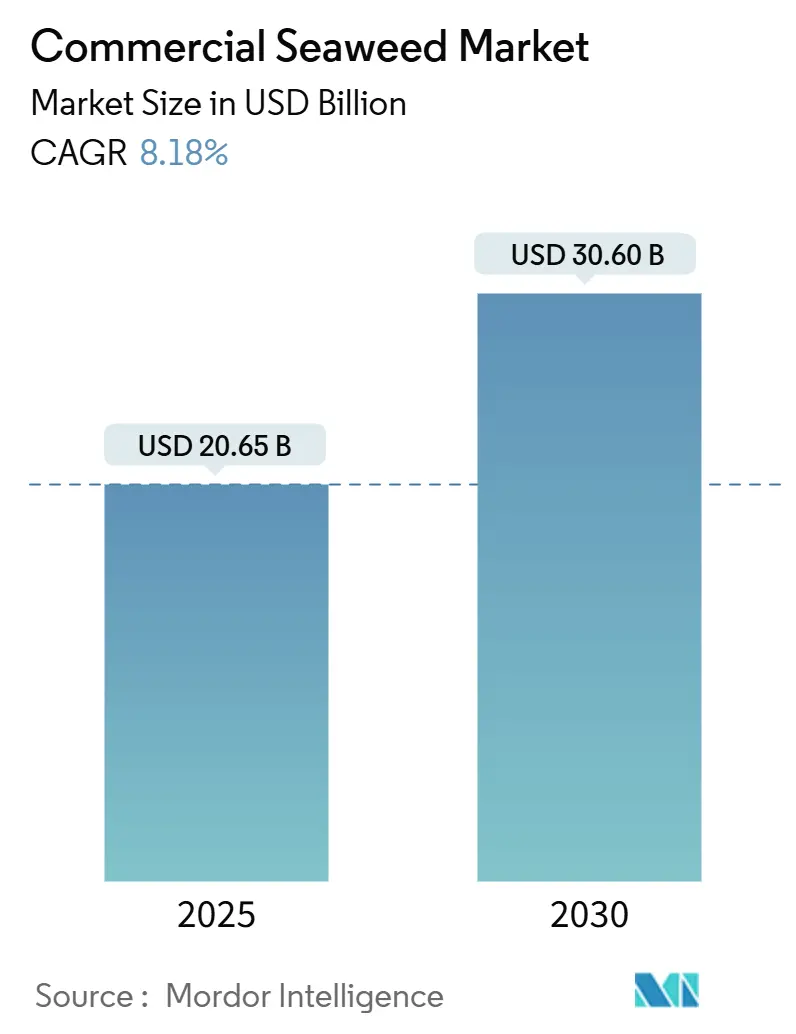
Commercial Seaweed Market Analysis by Mordor Intelligence
The global commercial seaweed market size is projected to grow from USD 20.65 billion in 2025 to USD 30.60 billion by 2030, registering a compound annual growth rate (CAGR) of 8.18%. The market has expanded beyond traditional food applications into pharmaceuticals, cosmetics, and sustainable packaging solutions. This growth is driven by increasing demand for natural food additives, government initiatives supporting coastal aquaculture, and seaweed's contribution to climate change mitigation through carbon sequestration. The cosmetic industry's increasing incorporation of seaweed in skincare products drives market demand. Seaweed provides hydrating, anti-aging, and anti-inflammatory properties in cosmeceutical applications. Companies formulate creams, masks, and serums with seaweed extracts to meet consumer demand for natural and marine-based skincare products, expanding the commercial seaweed market's applications. Moreover, government initiatives have significantly influenced seaweed market development through public funding, regulatory frameworks, and policy incentives. Countries including China, South Korea, and Norway have implemented programs to enhance cultivation techniques, processing efficiency, and supply chain operations. These measures have strengthened research capabilities, improved production methods, and increased export potential.
Key Report Takeaways
- By product type, red seaweed led with 48.21% of seaweed market share in 2024, while brown seaweed is forecast to expand at 10.20% CAGR during 2025-2030.
- By flavor, plain led with 62.04% of seaweed market share in 2024, while flavored is forecast to expand at 9.87% CAGR during 2025-2030.
- By cultivation method, aquaculture accounted for 92.02% share of the seaweed market size in 2024; wild harvest is projected to grow at 9.4% CAGR through 2030.
- By application, food & beverages captured 61.22% of the seaweed market in 2024; animal feed and pet food is set to accelerate at 10.07% CAGR to 2030.
- By form, frozen/dried products held 42.51% share of the seaweed market size in 2024, whereas fresh/chilled formats are rising at 10.66% CAGR over the forecast period.
- By geography, Asia-Pacific dominated with 37.65% seaweed market share in 2024; Europe registers the fastest growth at 9.88% CAGR through 2030.
Global Commercial Seaweed Market Trends and Insights
Drivers Impact Analysis
| Driver | (~) % Impact on CAGR Forecast | Geographic Relevance | Impact Timeline |
|---|---|---|---|
| Growing Popularity of Vegan and Plant-Based Diets | +1.8% | Global, with strongest impact in North America and Europe | Medium term (2-4 years) |
| Seaweed Farming Supports Coastal Employment and Sustainability | +1.2% | Asia-Pacific core, expanding to Europe and Americas | Long term (≥ 4 years) |
| Rising Demand for Natural Food Additives and Binders | +1.5% | Global, led by North America and Europe | Short term (≤ 2 years) |
| Expanding Use in Pharmaceuticals and Nutraceutical Products | +2.1% | Europe and North America, emerging in Asia-Pacific | Medium term (2-4 years) |
| Government Support for Seaweed Cultivation and Research | +0.9% | Europe, North America, select Asia-Pacific markets | Long term (≥ 4 years) |
| Cosmetic Industry Uses Seaweed for Skin Care Products | +0.7% | Global, premium markets in developed regions | Medium term (2-4 years) |
| Source: Mordor Intelligence | |||
Growing Popularity of Vegan and Plant-Based Diets
Plant-based dietary shifts accelerate seaweed adoption as consumers seek nutrient-dense alternatives to animal proteins, with seaweed providing essential amino acids, omega-3 fatty acids, and minerals often lacking in terrestrial plant foods. The sector benefits from seaweed's unique umami flavor profile, which enhances plant-based meat alternatives and dairy substitutes without requiring synthetic flavor enhancers. Recent innovations include seaweed-based protein isolates achieving 85% protein content, comparable to traditional animal sources, while maintaining superior digestibility coefficients. European markets lead this trend, with Netherlands-based companies developing seaweed protein concentrates for meat alternative applications, supported by EUR 9 million in EU funding for seaweed processing innovations [1]EU Commission, “€9 Million Boost for Seaweed Innovation,” The Fish Site, thefishsite.com. The convergence of health consciousness and environmental awareness positions seaweed as a cornerstone ingredient in the expanding plant-based food ecosystem, particularly as production costs decline through automation and scale economies.
Seaweed Farming Supports Coastal Employment and Sustainability
Seaweed cultivation creates resilient coastal economies while delivering measurable environmental benefits, with farms providing employment for 90,000 to 120,000 families in Indonesia alone and generating significant carbon sequestration capabilities [2]The Nature Conservancy, “Seaweed Aquaculture for Coastal Resilience,” nature.org. The industry's environmental credentials extend beyond carbon capture, with seaweed farms demonstrating pH buffering effects that create refugia from ocean acidification, elevating local pH levels, and supporting marine biodiversity. Seaweed farming offers coastal communities an accessible alternative to traditional aquaculture, with lower initial costs and multiple annual harvests providing consistent income. The industry's high participation of women farmers in many regions has led to increased policy support, as cultivation activities enable economic independence and community leadership roles [3]United Nations Conference on Trade and Development, "An Ocean of Opportunities: The Potential of Seaweed to Advance Food, Environmental and Gender Dimensions of the SDGs," unctad.org. These environmental and socioeconomic benefits have resulted in growing support from governments and international development organizations.
Rising Demand for Natural Food Additives and Binders
Food manufacturers increasingly substitute synthetic additives with seaweed-derived hydrocolloids, driven by clean label trends and regulatory pressure on artificial ingredients, with carrageenan and alginate markets experiencing sustained growth despite safety re-evaluations. The European Food Safety Authority's 2024 reassessment of carrageenan maintains its approved status while establishing stricter molecular weight specifications, creating opportunities for premium suppliers offering refined products [4]European Food Safety Authority, “Re-evaluation of Carrageenan (E 407),” EFSA, efsa.europa.eu. Seaweed-derived thickeners and stabilizers command price premiums of 15-30% over synthetic alternatives in premium food applications, reflecting consumer willingness to pay for natural ingredients with functional benefits. Innovation in extraction technologies enables producers to develop specialized hydrocolloid blends optimized for specific applications, from dairy alternatives requiring heat stability to gluten-free baking applications demanding improved texture profiles. The trend toward functional foods amplifies demand for seaweed additives that provide nutritional benefits beyond their technical functions, positioning suppliers who can demonstrate bioactive compound retention through processing.
Expanding Use in Pharmaceuticals and Nutraceutical Products
Pharmaceutical applications drive high-value seaweed utilization as bioactive compounds demonstrate efficacy in cancer therapy, immune system modulation, and drug delivery systems, with fucoidan and sulfated polysaccharides showing particular promise in clinical applications. The nutraceutical segment benefits from seaweed's concentrated micronutrient profile, with single servings providing 100-300% of daily iodine requirements and significant levels of vitamin B12, rare in plant sources. Regulatory pathways for seaweed-derived pharmaceuticals are advancing, with the FDA's recognition of seaweed as Generally Recognized as Safe (GRAS) facilitating ingredient approval processes for dietary supplements and functional foods. Research institutions are developing seaweed-based drug delivery systems that leverage natural polysaccharides for controlled release applications, potentially reducing manufacturing costs compared to synthetic polymer systems. The convergence of traditional medicine validation and modern pharmaceutical development creates opportunities for seaweed-derived therapeutics in both Western and Asian markets.
Restraints Impact Analysis
| Restraint | (~) % Impact on CAGR Forecast | Geographic Relevance | Impact Timeline |
|---|---|---|---|
| Risk of Heavy Metal Contamination in Seaweed Products | -1.4% | Global, particularly Europe and North America, with strict regulations | Short term (≤ 2 years) |
| Climate Change Affects Seaweed Farming and Yields | -0.8% | Global, with a severe impact in tropical regions | Long term (≥ 4 years) |
| High Labor Cost in Traditional Harvesting Methods | -1.1% | Europe, North America, developed coastal regions | Medium term (2-4 years) |
| Competition From Synthetic Additives and Marine Substitutes | -0.9% | Global, strongest in cost-sensitive industrial applications | Short term (≤ 2 years) |
| Source: Mordor Intelligence | |||
Risk of Heavy Metal Contamination in Seaweed Products
The accumulation of heavy metals in seaweed products poses regulatory compliance challenges and consumer safety concerns. Studies have found that arsenic, cadmium, lead, and mercury levels in samples from industrial coastal areas exceed safety standards, which impedes market growth. The contamination issue disproportionately affects wild-harvested seaweed from areas with industrial activity, creating competitive advantages for controlled aquaculture operations in pristine waters. Regulatory responses vary significantly across markets, with the EU implementing strict maximum residue limits while other regions lack harmonized standards, creating trade barriers and compliance costs for international suppliers. Processing innovations, including high-pressure treatment and selective extraction methods, can reduce heavy metal content by 50-70%, though these technologies add production costs and complexity.
Climate Change Affects Seaweed Farming and Yields
Ocean warming and acidification disrupt traditional seaweed cultivation patterns, with temperature increases of 2-3°C reducing yields of temperate species by 20-40% while shifting optimal growing zones poleward. Disease outbreaks linked to climate stress have devastated production in key regions due to pest and disease pressures exacerbated by warming waters. Adaptation strategies include selective breeding programs for climate-resilient cultivars and geographic diversification of production to higher latitudes, though these require significant investment and time to implement effectively. Offshore cultivation systems offer partial solutions by accessing more stable deep-water conditions, but require substantial capital investment and advanced technology platforms. The industry's long-term viability depends on successful adaptation to changing ocean conditions while maintaining economic competitiveness.
Segment Analysis
By Product Type: Brown Seaweed Drives Innovation
Brown seaweed grows at a 10.20% CAGR through 2030, while red seaweed holds 48.21% market share in 2024. The growth in brown seaweed stems from advances in alginate extraction and biostimulant applications. Red seaweed maintains market leadership through carrageenan and agar applications in food processing, while green seaweed serves niche fresh food markets and sustainable packaging applications. The segmentation by product type shows distinct value chains, with brown seaweed achieving higher prices in pharmaceutical and agricultural applications due to its bioactive compounds, including fucoidan and laminarin.
Brown seaweed processing technologies now enable multiple value streams from single biomass inputs, with biorefineries achieving 90% biomass utilization compared to 60% in traditional single-product extraction. Green seaweed's rapid growth and high protein content make it suitable for alternative protein markets and biodegradable film production. The market favors integrated producers who optimize cultivation and processing for multiple product streams, reducing costs while maximizing revenue per tonne of harvested biomass.
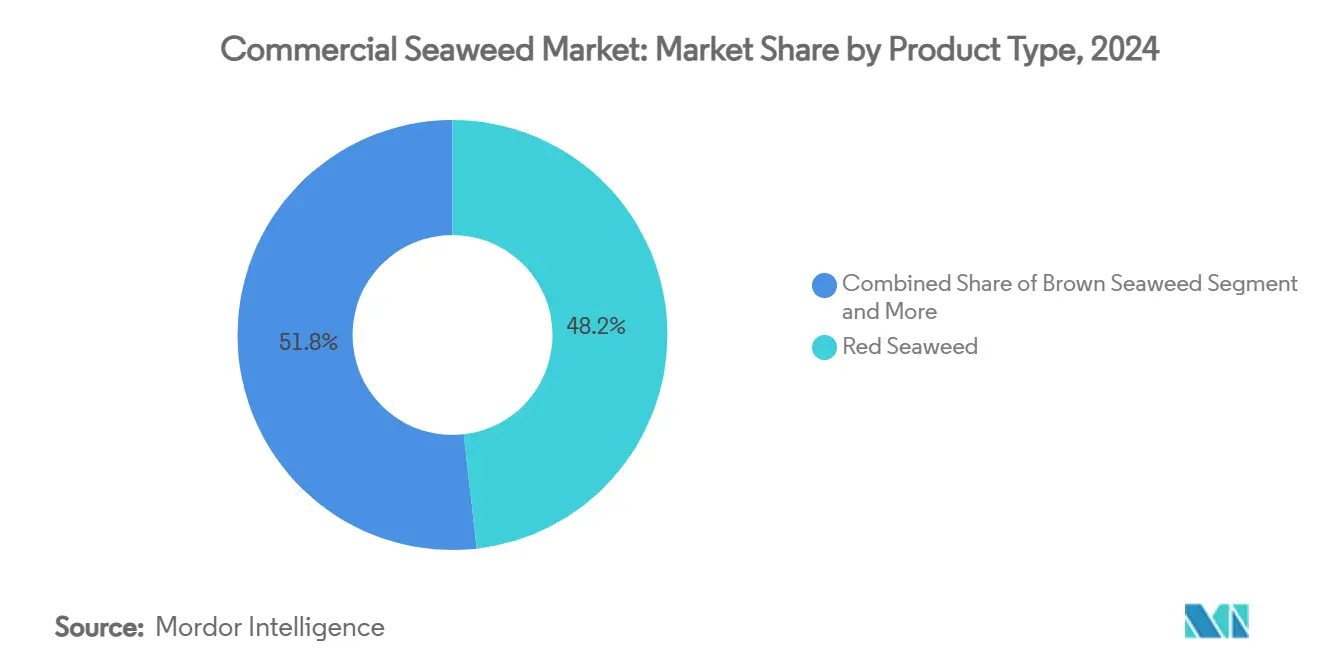
Note: Segment shares of all individual segments available upon report purchase
By Flavor: Flavored Products Gain Momentum
Plain seaweed products maintain a dominant 62.04% market share in 2024, while flavored alternatives grow at a 9.87% CAGR through 2030. This growth stems from Western consumer preferences and product formulations that reduce seaweed's natural oceanic taste. Flavor preferences vary by region, with Asian markets favoring plain seaweed and Western markets favoring seasoned and processed products. Manufacturers focus on umami enhancement and fusion flavors to integrate seaweed into familiar taste profiles, expanding beyond traditional consumer bases.
Manufacturers utilize seaweed's natural glutamate content to develop savory snacks and seasonings as alternatives to conventional flavor enhancers, providing clean-label options to monosodium glutamate. Processing technologies enable flavor incorporation during cultivation through nutrient supplementation, producing naturally flavored seaweed without post-harvest additives. Flavored products command a 40-60% price premium over plain variants, attracting manufacturer investment while increasing consumer acceptance in emerging markets.
By Cultivation Method: Aquaculture Dominance with Wild Harvest Premiums
Aquaculture commands 92.02% market share in 2024 while wild harvest accelerates at 9.4% CAGR through 2030, reflecting premium market demand for traditionally harvested products and sustainability concerns about cultivation impacts. The cultivation method segmentation reveals distinct value propositions, with farmed seaweed offering consistent quality and supply while wild-harvested products command premium prices for artisanal and organic market segments. Aquaculture benefits from technological advances in offshore cultivation systems and automated harvesting, reducing labor costs while increasing production scalability.
Wild harvest operations face increasing regulatory scrutiny regarding sustainability and ecosystem impact, creating opportunities for certified sustainable harvesting programs that can command price premiums of 50-100% over farmed alternatives. The cultivation method choice impacts product characteristics, with wild seaweed often exhibiting higher concentrations of bioactive compounds due to environmental stress factors. Integrated approaches combining aquaculture efficiency with wild harvest quality characteristics emerge through selective breeding programs and controlled stress cultivation techniques.
By Form: Fresh Products Challenge Processing Paradigms
Fresh/chilled seaweed is projected to grow at a 10.66% CAGR through 2030, while frozen/dried products maintain a dominant 42.51% market share in 2024. This growth is driven by improvements in cold-chain infrastructure and increased local cultivation, enabling efficient distribution of fresh products to urban markets. The market segmentation by form reflects existing supply chain capabilities and evolving consumer preferences, with fresh products commanding 2-3 times higher prices despite requiring advanced logistics and careful shelf life management.
The choice of processing format significantly influences nutritional content, with fresh products retaining higher levels of heat-sensitive vitamins and bioactive compounds compared to dried alternatives. Modified atmosphere packaging technology has extended fresh seaweed shelf life, enabling wider geographic distribution while maintaining product quality and nutritional value. Frozen/dried products continue to dominate industrial applications and export markets due to established supply chains and extended storage capabilities. The development of freeze-drying technologies offers a hybrid solution that preserves fresh product characteristics while providing extended shelf life.
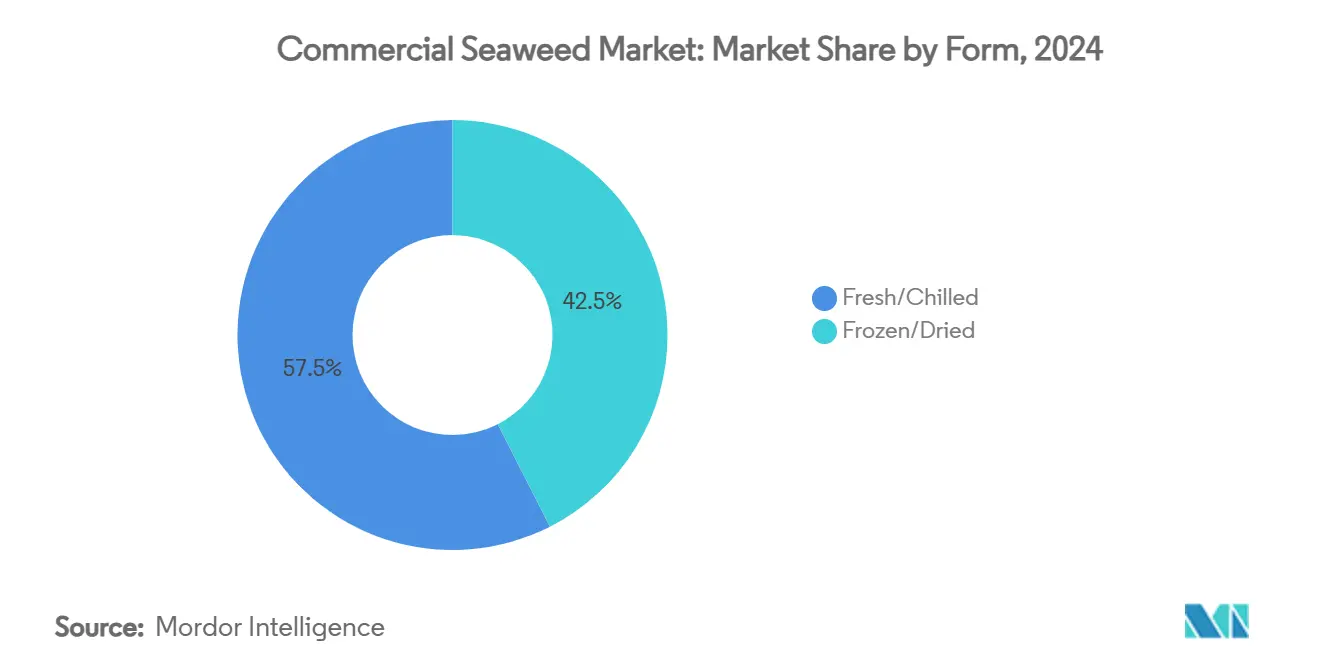
By Application: Animal Feed Transformation Accelerates
Food and beverages maintain 61.22% market share in 2024, yet animal feed and pet food surge at 10.07% CAGR through 2030. The increasing adoption of seaweed in food and beverage applications is driven by its nutritional benefits and functional properties. Seaweed contains essential vitamins, minerals, proteins, dietary fiber, iodine, and omega-3 fatty acids. The growing consumer awareness of these health benefits, combined with the rising demand for plant-based alternatives, has expanded seaweed's use as a sustainable protein source in vegetarian and vegan products. Its natural food thickening and gelling properties make it an effective clean-label ingredient. Seaweed's versatile applications span functional foods, natural food colorants, stabilizers, and emulsifiers, contributing to market growth.
The demand for seaweed in animal feed and pet food applications is increasing due to its proven ability to reduce livestock methane emissions and improve animal health. Research shows that Asparagopsis species in animal feed can significantly reduce cattle methane emissions by up to 80%. The incorporation of seaweed in animal feed has demonstrated multiple benefits, including enhanced digestive efficiency, improved immune function, and better nutrient absorption in livestock. Additionally, seaweed supplements in pet food have shown positive effects on coat health, digestion, and overall well-being of companion animals. These benefits, combined with the growing focus on sustainable agriculture practices, have positioned seaweed as a valuable ingredient in the animal nutrition industry, providing both environmental and economic benefits.
Geography Analysis
Asia-Pacific dominates with 37.65% market share in 2024, leveraging established aquaculture infrastructure and traditional consumption patterns, while facing challenges from climate change impacts and increasing production costs in key growing regions. China leads regional production with advanced cultivation technologies and integrated processing capabilities, though environmental regulations and labor cost inflation pressure margins. Japan and South Korea focus on premium product segments and technological innovation, developing automated harvesting systems and value-added processing techniques that maintain competitive advantages despite higher production costs. Indonesia and the Philippines benefit from favorable growing conditions and government support programs, though disease outbreaks and quality control challenges limit export market access.
Europe emerges as the fastest-growing region at 9.88% CAGR through 2030, driven by regulatory support for sustainable packaging applications and pharmaceutical innovations that leverage the region's advanced bioprocessing capabilities. Nordic countries lead European cultivation efforts, with Iceland and Norway developing offshore farming systems optimized for harsh marine conditions, while the Netherlands and Germany focus on land-based cultivation technologies that enable year-round production. The European market commands premium pricing through strict quality standards and traceability requirements, creating barriers to entry while rewarding compliant suppliers with sustainable margins. Policy support includes recognition of seaweed's carbon sequestration benefits and integration into blue economy strategies, positioning the region for continued growth leadership.
North America shows strong momentum in specialty applications and technological innovation, with the United States investing USD 25 million in offshore seaweed biomass production and developing advanced processing facilities in Maine and Alaska. Canada focuses on sustainable harvesting practices and indigenous community partnerships, while Mexico benefits from Ocean Rainforest's recent acquisition of Alamarsa, bringing advanced cultivation technologies to Latin American markets. . The region's growth potential stems from large coastal areas suitable for cultivation and strong demand for natural food ingredients.
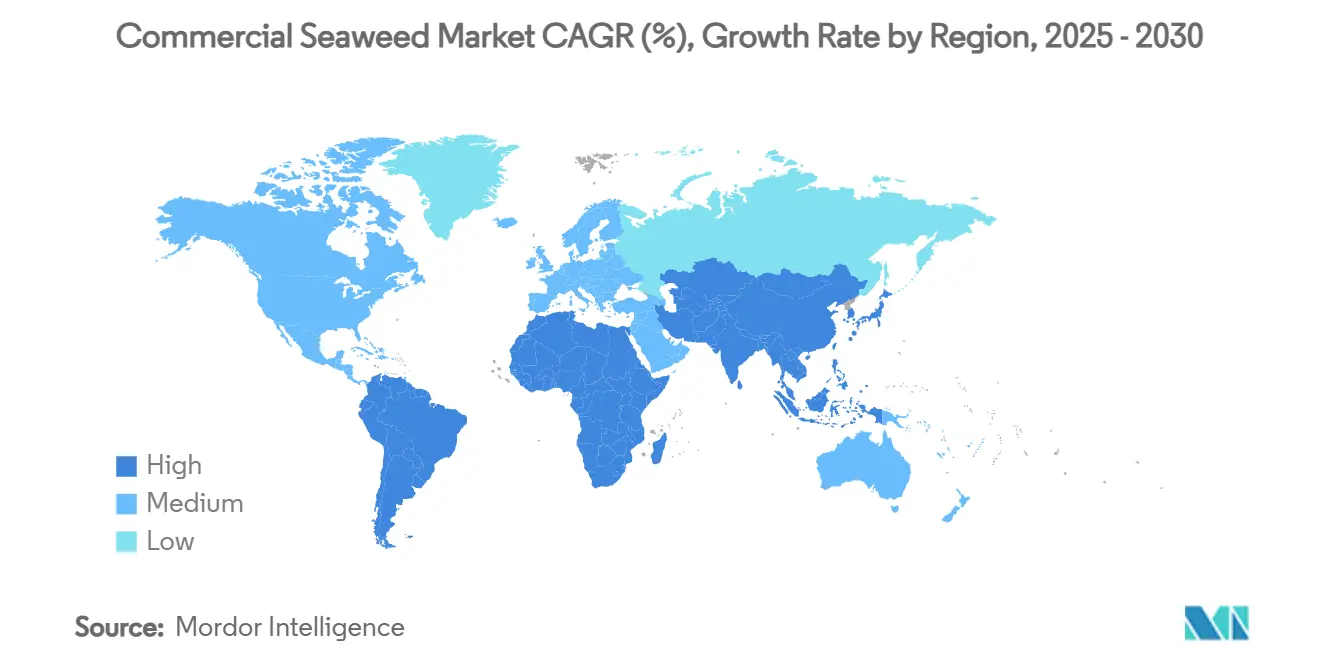
Note: Regional shares of all individual regions will be available upon report purchase
Competitive Landscape
The seaweed market exhibits fragmented competition with a concentration score of 3 out of 10, creating opportunities for consolidation through vertical integration and technology-driven differentiation strategies. Major leaders in the commercial seaweed market include Cargill Inc., CP Kelco, Gelymar, Acadian Seaplants, and Qingdao Bright Moon Seaweed Group. Market fragmentation stems from geographic dispersion of production, specialized application requirements, and the industry's evolution from traditional harvesting to modern aquaculture systems.
Leading players pursue different competitive strategies, with Asian producers focusing on scale and cost efficiency while European and North American companies emphasize quality, sustainability, and value-added processing capabilities. Technology adoption emerges as a key differentiator, with companies investing in automated harvesting systems, offshore cultivation platforms, and biorefinery processing to achieve competitive advantages.
The industry is experiencing increased consolidation through strategic acquisitions and partnerships that integrate cultivation, processing, and distribution capabilities. Major companies are vertically integrating their operations to control quality, reduce costs, and strengthen market positions. This consolidation trend is particularly evident in mature markets where firms seek economies of scale. These segments present significant barriers to entry due to stringent technical requirements, complex regulatory frameworks, and the need for specialized expertise in research and development.
Commercial Seaweed Industry Leaders
-
CP Kelco
-
Cargill Inc.
-
Acadian Seaplants
-
Gelymar
-
Qingdao Bright Moon Seaweed Group
- *Disclaimer: Major Players sorted in no particular order
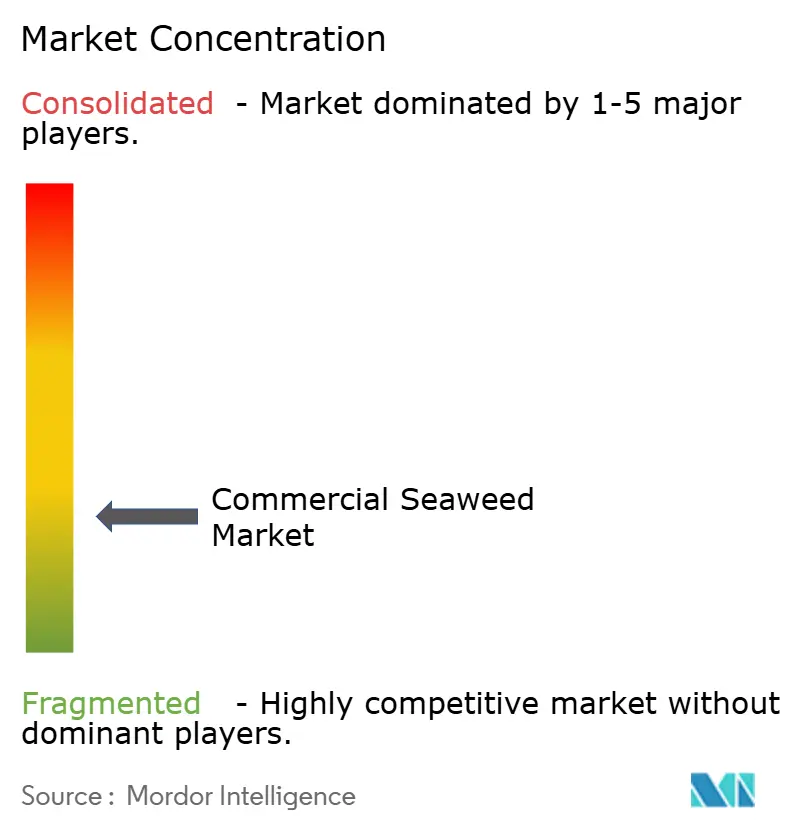
Recent Industry Developments
- February 2025: Ocean Rainforest acquired a majority stake in Mexican seaweed producer Alamarsa, combining Alamarsa's extraction expertise with Ocean Rainforest's open-ocean farming technology to enhance sustainable seaweed-based products and expand market access in North America.
- February 2025: Nordic SeaFarm and FutureLab & Partners formed a partnership to explore seaweed's potential in biomaterials and sustainable manufacturing processes, reflecting growing interest in utilizing seaweed as a resource across various industries beyond traditional food applications
- January 2025: US Department of Energy pledged USD 25 million to advance seaweed biomass production in the Exclusive Economic Zone, demonstrating significant government commitment to developing the domestic seaweed industry for energy and environmental applications.
Global Commercial Seaweed Market Report Scope
Seaweeds are a group of photosynthetic, non-flowering, plant-like organisms (called microalgae) that live in the sea.
The market is segmented by product type, application, and geography. By product type, the market is segmented into Red, Brown, and Green Seaweed. Based on application, the market is segmented into food and beverage (hydrocolloids, thickeners, gelling agents, ice-cream stabilizers, and others), dietary supplements, pharmaceutical and medical, and other applications. Based on geography, the market includes major geographies across the region, North America, Europe, Asia-Pacific, South America, the Middle East, and Africa.
For each segment, the market sizing and forecast have been done based on the value (in USD million).
| Brown Seaweed |
| Green Seaweed |
| Red Seaweed |
| Plain |
| Flavored |
| Fresh/Chilled |
| Frozen/Dried |
| Aquaculture (Farmed) |
| Wild Harvest |
| Food & Beverages |
| Dietary Supplements |
| Pharmaceuticals |
| Animal Feed & Pet Food |
| Cosmetics & Personal Care |
| Others |
| North America | United States |
| Canada | |
| Mexico | |
| Rest of North America | |
| Europe | Germany |
| United Kingdom | |
| Italy | |
| France | |
| Spain | |
| Netherlands | |
| Poland | |
| Belgium | |
| Sweden | |
| Rest of Europe | |
| Asia-Pacific | China |
| India | |
| Japan | |
| Australia | |
| Indonesia | |
| South Korea | |
| Thailand | |
| Singapore | |
| Rest of Asia-Pacific | |
| South America | Brazil |
| Argentina | |
| Colombia | |
| Chile | |
| Peru | |
| Rest of South America | |
| Middle East and Africa | South Africa |
| Saudi Arabia | |
| United Arab Emirates | |
| Nigeria | |
| Egypt | |
| Morocco | |
| Turkey | |
| Rest of Middle East and Africa |
| By Product Type | Brown Seaweed | |
| Green Seaweed | ||
| Red Seaweed | ||
| By Flavor | Plain | |
| Flavored | ||
| By Form | Fresh/Chilled | |
| Frozen/Dried | ||
| By Cultivation Method | Aquaculture (Farmed) | |
| Wild Harvest | ||
| By Application | Food & Beverages | |
| Dietary Supplements | ||
| Pharmaceuticals | ||
| Animal Feed & Pet Food | ||
| Cosmetics & Personal Care | ||
| Others | ||
| By Geography | North America | United States |
| Canada | ||
| Mexico | ||
| Rest of North America | ||
| Europe | Germany | |
| United Kingdom | ||
| Italy | ||
| France | ||
| Spain | ||
| Netherlands | ||
| Poland | ||
| Belgium | ||
| Sweden | ||
| Rest of Europe | ||
| Asia-Pacific | China | |
| India | ||
| Japan | ||
| Australia | ||
| Indonesia | ||
| South Korea | ||
| Thailand | ||
| Singapore | ||
| Rest of Asia-Pacific | ||
| South America | Brazil | |
| Argentina | ||
| Colombia | ||
| Chile | ||
| Peru | ||
| Rest of South America | ||
| Middle East and Africa | South Africa | |
| Saudi Arabia | ||
| United Arab Emirates | ||
| Nigeria | ||
| Egypt | ||
| Morocco | ||
| Turkey | ||
| Rest of Middle East and Africa | ||
Key Questions Answered in the Report
What is the current value of the seaweed market?
The seaweed market size is valued at USD 20.65 billion in 2025 and is projected to reach USD 30.60 billion by 2030.
Which region grows the fastest?
Europe registers the highest growth at a 9.88% CAGR between 2025-2030, driven by regulatory incentives and rising demand for sustainable packaging.
Which product type holds the largest share?
Red seaweed leads with 48.21% of global seaweed market share in 2024, supported by carrageenan and agar applications.
How fragmented is the competitive landscape?
The seaweed market remains highly fragmented, giving a concentration score of 3.
Page last updated on:
